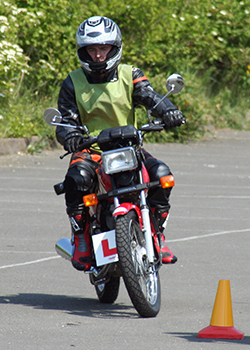 On 19th January 2013, a European Directive (3rd European Driving Licence Directive) was implemented. The directive included a raft of changes to the motorcycle licence and testing requirements for new riders.
On 19th January 2013, a European Directive (3rd European Driving Licence Directive) was implemented. The directive included a raft of changes to the motorcycle licence and testing requirements for new riders.
We had meant to add the “GET ON” campaigns “Routes to Riding” flow chart up on the website for a while now and finally we have managed to do it. The chart breaks down the new motorbike licensing laws, making it easy for learners to see the exact path they need to take to get on two wheels!
Also recently we have been pointed to the NI Direct website and the addition of a page entitled, “Safety helmets and protective clothing for motorcyclists” the page includes a section on “Clothing Requirements for Test”.
This would appear to have replicated advice issued last year by the DSA (Driving Standards Agency) in GB.
If you are taking your test or are a trainer, you need to be aware of this “advice” as we have been made aware of a rider recently who turned up to take his test and was turned away because he was NOT wearing the minimum level of footware acceptable to DVA (Driver Vehicle Agency).
It should be noted that the “Clothing Requirements for Test” points out that the only legal requirement when riding on the road is, the requirement to wear a safety helmet with the exception of members of the Sikh religion who can wear a turban. “All helmets must comply with the British Standard (BS6658: 1985) and carry the BSI Kitemark or the UNECE regulations 22.05 mark.”
Compulsory Basic Training (CBT), which all learner moped and motorcycle riders must complete before they can ride unaccompanied on public roads, has a section in its syllabus which covers the importance of the right equipment and clothing, including the correct fitting and securing of safety helmets.
The Northern Ireland motorcycling community is safety conscious and riders have purchased protective clothing worth hundreds of thousands of pounds. In a response to a questionnaire by BikeSafe Northern Ireland, riders demonstrated that the overwhelming majority of motorcyclists use correct protective clothing.
- 96.2% – Jacket with reinforced padding/armour on the elbow, shoulders or back.
- 87.8% – Boots with reinforced padding/armour on the ankle, knee or shin.
- 87.6% – Trousers with reinforced padding/armour on the knee, outer knee or hip.
- 80.5% – Gloves with knuckle/palm guard.
There is NO requirement that any clothing – Jacket – Trousers – Boots – Gloves – should be marked as PPE (Personal Protective Clothing) no matter what an examiner tells you.
Get On – Routes to Riding
Get On’s Routes to Riding chart breaks down the new motorbike licensing laws, making it easy for you to see the exact path you need to take to get on two wheels!
Get On is a Motorcycle Industry funded campaign which aims to introduce as many people as possible to the fun, freedom and financial savings that can be made when you learn to ride a motorbike or scooter.
There are over 100 centres around the country, including Northern Ireland, that offer a free motorcycle training session allowing you to experience for yourself just how easy it is to ride!
All the kit is provided and you get personal guidance from a trained professional in a safe and secure area away from cars so you can relax and enjoy yourself.
And it’s completely free.
There’s no catch!
Routes To Riding – pdf – 749kb – Click Here
Clothing Requirements for Test
It is a legal requirement to wear a safety helmet when riding on the road with the exception of members of the Sikh religion who can wear a turban.
All helmets must comply with the British Standard (BS6658: 1985) and carry the BSI Kitemark or the UNECE regulations 22.05 mark.
The Agency has a duty of care to test candidates, therefore it is DVA policy that candidates wear appropriate protective clothing and fluorescent or reflective apparel, throughout the duration of the test. For example it would not be safe or appropriate to wear a T-shirt, shorts and sandals.
The following is an indication of the minimum level of clothing acceptable to DVA:
- motorcycle boots
- sturdy footwear or boots that provide support and ankle protection
- textile or leather motorcycle trousers
- heavy denim trousers
- heavy denim jacket with several layers underneath
- textile or leather motorcycle jacket
- motorcycle gloves
The following are examples of clothing that are not acceptable to DVA:
- lightweight training shoes
- plimsolls or canvas basket ball trainers
- any form of clothing with areas of exposed skin
- shell suit or lightweight tracksuit
- distressed ripped jeans
- lightweight fleece or hoody
- no gloves or skiing gloves
If the examiner considers your clothing as being unacceptable to allow the test to continue, he/she may allow you some time to meet the minimum clothing requirements following which if the requirements cannot be met your test will not be conducted.
View the full page on NI Direct – Click Here



Speak Your Mind